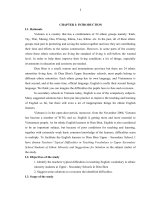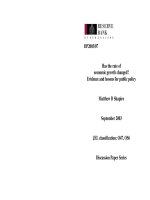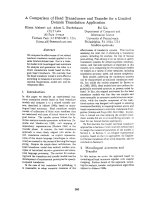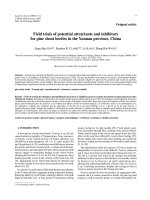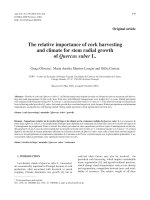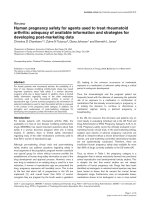Organizational culture of Japanese firms and lessons for Vietnameses enterprises
Bạn đang xem bản rút gọn của tài liệu. Xem và tải ngay bản đầy đủ của tài liệu tại đây (494.67 KB, 10 trang )
TRƯỜNG ĐẠI HỌC KINH TẾ - ĐẠI HỌC ĐÀ NẴNG
VĂN HÓA TỔ CHỨC CỦA CÁC DOANH NGHIỆP NHẬT BẢN
VÀ BÀI HỌC CHO CÁC DOANH NGHIỆP VIỆT NAM
ORGANIZATIONAL CULTURE OF JAPANESE FIRMS AND LESSONS FOR
VIETNAMESES ENTERPRISES
Ngày nhận bài: 20/08/2019
Ngày chấp nhận đăng: 11/02/2020
Lê Thị Ngọc Lan, Hoàng Anh Duy
ABSTRACT
Organizational culture or corporate culture is a special asset of an organization which was once
considered as “precious spiritual treasure”. It plays an important role in organizations. This paper
reviews the definition, importance and the structure of organizational culture as the background to
analyze common characteristics of Japanese firms’ culture. Specifically, the organizational culture
of Panasonic and Isowa are diagnosed to provide the outstanding aspects of them in order to give
some lessons for Vietnamese enterprises.
Keywords: organizational culture, corporate culture, Japan
1. Introduction
Organizational culture helps create the
unique identities for each organization,
reduce risks through the underlying
coordination and controlling system,
motivate members to work effectively and
develop
organizational
competitive
advantages (Schein, 1985). This is because of
the beliefs, values and underlying
assumptions which are shared among
members within the organization. Japanese
organizations have paid attention and efforts
to develop their cultures with special
characteristics that have contributed to their
success over the years. That is the reason
why studying organizational culture of
Japanese firms is necessary for other
enterprises to build and develop strong
cultures. This paper will review some
literatures on organizational culture, then
study some outstanding culture of Japanese
firms. By understanding the culture of these
firms and the way they develop
organizational culture, some lessons can be
learnt by Vietnamese enterprises.
60
2. Literature
methodology
review
and
Research
2.1. Literature review
2.1.1. Definition
According to Bate (1994), organisational
culture or corporate culture is defined in
different
ways
of
‘anthropological’
researchers and ‘scientific rationalists’.
Anthropological
researchers
considered
organisational culture (like national cultures)
as a pattern of shared basic assumptions
which were developed and learnt by a group
to deal with the issues of external and internal
environment; it became valid after having
worked well enough to be considered as a
good way to perceive, think and behave
(Schein, 1985). For example, Ogbonna
(1992) defines organisational culture as the
results of interlacing a person into a
community and ‘collective programming of
the mind that distinguish members’; it
includes ‘norms, values, beliefs, and customs’
of an individual which are in common with
Lê Thị Ngọc Lan, Hoàng Anh Duy, Trường Đại
học Ngoại Thương
TẠP CHÍ KHOA HỌC KINH TẾ - SỐ 8(01) - 2020
other individuals of a community. Another
definition of organisational culture which is
considered as frequently used and helpful
(Herzog, 2008) was provided by Edgar
Schein.
Schein
(1985:
9)
defines
organisational culture as follows: “A pattern
of shared basic assumptions that the group
learned as it solved its problems that has
worked well enough to be considered valid
and is passed on to new members as the
correct way to perceive, think, and feel in
relation to those problems.”
culture in later researches. Schein (1985)
argues that there are three levels of
organisational culture which are artefacts,
espoused beliefs and values, and underlying
assumptions. These three levels are shown in
Figure 1 below.
In these approaches, leaders are not the
persons who initially created organisational
culture, however, their behaviours and beliefs
became assumptions day by day which can
be shared by members within the
organisations.
Whereas in the perspective of ‘scientific
rationalists’, organisational culture is seen as
“important value, beliefs, and understandings
that members share in common’ that could
provide managers with better ways of
thinking and responding in order to make
decisions and manage the organisations (Sun,
2008). Similarly, Denison (1990) indicates
that organisational culture is ‘underlying
values, beliefs, and principles’ which develop
the management system of the organisation.
In short, although there have been different
approaches of organisational culture, most
theorists have some similarities in defining
organisational culture which are generally
described as sets of norms, values, beliefs,
attitudes, symbols, and behaviours that are
shared by all members within an organisation
that represent the unique characteristic of the
organisation (Morgan, 1997).
2.1.2. Structure of Organisational Culture
Edgar Schein, one of the foremost
researchers in topic, proposes a structural
model of organisational culture which is used
as a framework to analyse organisational
Figure 1. Schein (1985)’s model of organizational
culture
The first level is artefacts which are
tangible and easily seen by outsiders. For
example,
customs,
office
design,
architecture, celebrations, rituals and
language are artefacts. However, Schein
(1985) notes that it is hard to decipher these
elements because they only show the
superficial aspects of organisational culture,
so it is necessary to understand other levels
when studying an organisational culture. The
second level includes espoused values of the
organisation such as strategies, goals,
operating philosophies and principles which
can be directions to the behaviours within the
organisation. According Hofstede (1991), it
is difficult to see the values until it is
demonstrated by behaviours; Schein (1985)
also notes that values are only visible when
they are shared by members of an
organisation. An organisational culture
includes many values; some of them may get
along with others such as personal
61
TRƯỜNG ĐẠI HỌC KINH TẾ - ĐẠI HỌC ĐÀ NẴNG
achievement and independence, whereas
some may conflict with others such as team
work and autonomy. For Schein (1985), the
most important level of organisational culture
is the deepest level, underlying assumptions.
They are taken for granted and unconscious
and
deeply
entrenched.
Underlying
assumptions are considered as a way of
guiding behaviours by directing the way
people within an organisation should
perceive, think, and behave.
2.2. Research methods
Qualitative methods were seen as useful
ways to measure deeper level of
organisational culture, and quantitative
methods were only limited to shallower level
(Smircich, 1983; Ott, 1989; Schein, 1990).
Interpretive interactionism argues that
intangible aspects of social life such as
attitudes cannot be stated numerically
(Burgress, 1927; Blumer, 1969; Burrell and
Morgan, 1979). For them, only through
qualitative methods such as intensive
interviews,
the
deepest
level
of
organisational culture can be revealed.
Besides, observations can be used to have an
insight of visible elements of organizational
culture.
This research uses information from
lectures and discussion with Japanese experts
as well as observations through the field trip
in the framework of Keieijuku 8 executive
training course by VJCC Institution in 2017.
There were 16 Japanese organizations and
firms in manufacturing (ceramics, stell,
industrial machines, components), consumer
production (alcohol, soy sauce), Japanese
traditional restaurants and Japanese top
universities. The methods used in this
research include observations and in-depth
interviews
with
leaders
of
those
organizations to collect and clarify
information.
62
3. Findings and Discussion
3.1. Organizational culture of Japanese
firms
3.1.1. Overview to Japanese organizational
culture
Japan has a long historical and diversified
culture which has been influenced by the
thousand-years traditions as well as the
modern life with the top technology and
innovation in the world. Immigrations are not
encouraged in Japan, so Japan is a united
ethnic.
In order to have a sustainable
development business community, Japanese
firms have been paying attention to develop
their cultures. Over the history, obstacles and
natural disasters such as earthquakes and
tsunamis, Japanese have been strongly
standing up and reinforced their national
spirit of strength, patience, and endurance.
Especially, samurai spirit has been shared
from
generatiosn
to
generations.
Organizational culture is considered as the
core practice in relationship development and
management in Japneses organizational to
build the special characteristics which are
discipline and work effectiveness.
a) Dignification at the workplace
In Japan, during the meeting, each person
always gives his/her ideas clearly, slowly
whereas listeners pay their attention to the
speakers. The key point here is the
dignification at the workplace which leads to
seriousness, then work can be done
effectively. (through our field trip to 16
Japanese oganizations, it can be seen that
everything is prepapred and implemented
carefully and seriously such as the layout, the
atmosphere at the workplace, the solemn and
warm greetings, the safety at work, the
preparation for helmets, safety uniforms,
shoes to visit factories).
TẠP CHÍ KHOA HỌC KINH TẾ - SỐ 8(01) - 2020
b) Consistency and special identity
The unitedness of ethinics allows
Japanese to build a consistent and idenficable
culture. Shinto and Buddhism are two major
religions of Japanese people. They live
simply and purely, especially, friendly with
natural environment. They highly respect
which are gifted by nature and even consider
some natural phenomenon and resources as
angels. For example: Sun Angel, Sea Angel,
Mountain Angel, etc. Japanese people respect
those angels (Kami) and pray for them
protection. This can be seen through the
practice of producing Miso and Tamari soy
sauce in Morita aji no Yakata organization,
angels are respected during their production
and give them the beliefs in their production
know-how and tools which have been
protected for more than 300 years.
Japanese organizations always focus on
the consistency and identities in management
and development which help them implement
division of labor effectively and create
competitive advantages in the business
world. For example, Metal Heat Co. Ltd,
established in 1973, with revenue of 820
million yen and 50 employees, has built their
competitive advantages in heat treatment
techniques innovation and is proud of their
brand as the leader in vacuum heat treatment
industry in Japan.
c) Human focus
In Japanese’s opinions, the best resource
is human. Qualification and skills can be
trained while human psychology and
behaviors are the most important factors in
recruitment and selection. That is why people
will have orientation for their behaviors if
they understand the mission, vision,
philosophy and goals of the organization they
work for. In addition, Japanese leaders
always focus on people development, trust in
employees, motivate them and play the role
model for employees to follow. For example,
Mr. Yamamoto Nobutane (former CEO of
Panasonic) is respected widely by Japanese
businesspeople community and the business
world because of his opinions and practices
in human resources management and putting
a fire in the heart of employees.
d) Collectivism
The support of many people can bring
more confidence and power. Many Japanese
organizations requires employees to queue up
and speaj out loud their slogan as a way of
inspiration and determination. Isowa
Corporation is an example. The leader of
Isowa has collected ideas and evaluation on
his leadership from all employees over the
last 7 years that not only brings efficiency
improvement but also provides a good
opportunity for employees to show their
competencies and raise their voice on
internal issues of the organization. As a
result, the organization will be better and
employees will have more motivation and
trust. Similarly, Yabashi Holdings Co., Ltd
issues a quarterly press to motivate
employees. In this organization’s basic
assumptions, once employees and their
family are happy, the company will be
successful because they work and develop
their career for themselves, for their family
so that their family will have happiness and
prosperity when the company achieve
sustainable development.
e) Customer focus
Business philosophy of Japanese firms is
bringing satisfaction to customers, then
happiness to themselves. The success of the
company comes from the support of the
market and customers. Therefore, Japanese
firms will do their best to serve the
customers, truly care about them and satisfy
their needs and expectation. This is also the
standards to guide the behaviors of
employees in Japanese companies.
63
TRƯỜNG ĐẠI HỌC KINH TẾ - ĐẠI HỌC ĐÀ NẴNG
f) Social responsibility
Natural and environmental problems are
one of the important subjects in Japanese
education which nurture the young
generations the love with nature as well as
their autonomy. This is impressive to authors
after the visit to Yokkaichi Pollution and
Environmental
Museum
for
Future
Awareness and Kasumi Kyodo Jigyo Co.,
Ltd. That is why Japanese people have a
good habit of keeping the public places clean
and clear. Tables, chairs, boards and floors
are cleaned carefully and there is no rubbish
in the workplace. As a result, all employees
have their responsibility and involvement in
keeping the workplace clean, they can be
proud of their office and work mood is much
better. Clean and clear is one of the goals and
one of the criteria to achieve quality in many
Japanese organizations.
For Japanese people, doing business is not
only for profit but also for society, for
humanity, and working today for a brighter
tomorrow. Therefore, Japanese organizations
and especially the leaders always have the
social responsibility. They care about the
society when doing business, providing
products and services as well as thinking
about the future. They also conclude their
lessons and experiences for the next
generations, Mr. Matsushita and Mr.
Nobutane of Panasonic are 2 outstanding
examples.
From the above general characteristics of
Japanese
organizational
culture,
the
following part will focus on 2 case studies of
2 organizations which were observed much
and gave an impression and many lessons to
authors after the field trip.
3.1.2. Organizational culture of Panasonic
a) An overview to Panasonic
Panasonic was established in 1918 and
headquartes in Osaka, Japan with annual
64
revenue of 7.343 billion yen and 257.533
employees working in 495 subsidiaries.
Taking about Panasonic, the founder Mr.
Matsushita Konosuke is always mentioned as
"the god of management" who first started up
and developed Matsushita Electric Industrial
Co., Ltd. He is also the first businessman
who used the national brand for the product
of his company. Panasonic always focus on
developing cultural values through creating
and procting their brandname, developing
technology, designing products as well as
respecting history, developing sustainably,
being transparent and creating job
opportunities.
b) Artefacts
About the name, Panasonic is the
combination of "Pan"(Universal) and
"Sonic"(Sound) and has a meaning of
bringing sound our company creates to the
world. About logo, Panasonic Blue was first
adopted as a corporate color in 1974.
Panasonic Blue was introduced as a new
brand color, using a photo of the sky at dawn,
immediately before the sun rises from the
horizon, which symbolized the future and a
sense of anticipation, as a visual backdrop.
Its motif is the unique blue sky that can be
seen only for a brief moment at dawn when
the dark night sky changes to a bright
morning sky, representing new hopes for the
new day about to begin. The color suggests
sophistication, intelligence and motivation,
enhances the ability to focus and concentrate,
and gives a feeling of confidence to the
people around it.i
About slogan, Panasonic has changed the
slogan 3 times since 2003 from "Ideas for
Life" (2003–2013) to "A Better Life, A
Better World" (2013–2017) and now "Let's
Live Life Better". The new brand slogan is
based on the unchanging basic management
objective the company has adhered to since
TẠP CHÍ KHOA HỌC KINH TẾ - SỐ 8(01) - 2020
its founding and expresses the vision and
direction the company is striving to achieve.
Panasonic’s
vision
of
expanding
and pursuing a better life for each individual
customer with its various partners in
various spaces and fields and realizing a
better world globally through its contribution
to the environment and society.
About rituals, Panasonic follows the
traditional rituals of Japan such as salutation.
Every morning, all members of board of
management and employees will salute each
other, do the morning exercises and have
lunch together in the company’s canteen to
buld solidarity and consistency.
c) Espoused values
Basic
business
philosophy
helps
Panasonic
determine
our
objectives,
approach to business activities, and the
general direction of our company which has
been considered as as a compass, helping the
company set and maintain the right direction
for business since the establishment in 1918.
First, Panasonic focuses on finding valuable
resources, including human resources,
materials, funds and information. Next, these
resources are used to create value-added
products and services. Finally, these products
and services are made to be available all over
the world. Therefore, creating value and
contributing to society is the primary mission
to achieve sustainable development.
Following the business philosophy, over
the years, Panasonic has focused on the
quality products and services to customers as
well as implement many social activities
dealing with some problems of poverty,
energy, education, foods, medical and health.
Panasonic contributes to the society through
their business. One example is a project of
100,000 solid energy lanterns which were
assembled in developing countries in the
fiscal year 2012 to celebrate 100th year
anniversary of the company.
d) Basic underlying assumptions
From the philosophy of supporting the
society especially the next generations,
Panasonic believes that those generations
will contribute a sustainable society.
Panasonis Kids School was established to
provide favoured programs to support dreams
and future of children in the world.
Moreover, to save and spread the
organizational
traditions,
Panasonic
Konosuke Matsushita Museum was built to
show the ideological system of Mr.
Matsushita and his opinions, philosophies
and basic assumptions in management. For
him, the leaders should have a pure heart and
fresh mind with the love towards people and
strong beliefs towards a bright future for the
homeland. He was famous for his
philosophies including “pave the way”: “each
person has the own way to go. This way
sometimes is large and narrow, sometimes is
flat and sloping. However, you can find your
own way to go by your faith, brave, patience
and determination.” This philosophy has
become the beliefs and orientation for the
next generations.
3.1.3. Organizational culture of Isowa
a) An overview to Isowa
Isowa Corporation started a private
company with a small shop of Isowa family in
1920. Up to now, the corporation now works
in the fields of engineering, manufacture and
sales of corrugated machinery with 268
employees and the revenue of 12.4 billion yen
and 750 patents. From 2007-2012, Isowa
continueously achieved the awards and prized
granted by Japan Invention Promotion
Institute and Daily Industrial Newspaper
Publishing Company.
65
TRƯỜNG ĐẠI HỌC KINH TẾ - ĐẠI HỌC ĐÀ NẴNG
b) Artefacts
About logo, similar to Panasonic, Isowa
Corporation uses blue and white color for
logos and website. The color of workers’
uniform in Isowa factory is also blue and
white. For them, those colors express not
only the dream of flying high but also the
hygiene and well-order of the corporation.
Isowa tries their best to become the leading
corrgurated manufacturer with the clean
environment.
has the principle of “51%-49%: Family –
Work”, stating that family is more important
than work. That is why employees cannot be
required to love their jobs more than their
family. In addition to traditional rituals of
Japanese such as salutation and doing
exerices
together,
commemorative
ceremonies are organized to memorize the
death employees who dedicated for the
development of the corporation.
c) Espoused values
About slogan, “Supplying a dream in a
corrugated box.” and “A Dream Box made
by the Box Dream” were chosen because
Isowa tries to introduce to the market, is the
world’s first high-speed digital printer for the
wide-width corrugated sheet. Isowa’s
mission is rather large: trying to start a
revolution in the corrugated industry by
changing the conventional flexo printing to
digital printing. By using the Box Dream
Digital Printer, a company can run a zeroemission printing operation because waste
ink, wash water and cleaning solutions can
be eliminated. This will lead to production of
eco-friendly corrugated products. The
corrugated sheet can then establish itself as
environmentally responsible product.ii
Mr. Hideyuki Isowa - President and CEO
of Isowa is very passionate in developing the
organizational culture of Isowa with the aim
towards having the best corporate culture in
the world: where everyone can have
thoughtful discussion in a frank and open
atmosphere. Thoughtful management means
contributing to the society. For him, to
guarantee continued growth and existence, a
company president only has to worry about
two things: one is to create and maintain an
appropriate set of management strategies, the
other is to create a corporate culture in which
the employees can enjoy the work and want
to do a good job.
Besides, in the factory there is a slogan:
“Employee Satisfaction comes before
Customer Satisfaction. Employees cannot
create Customer Satisfaction if they are not
satisfied enough with their company.” For
leaders of Isowa, if employees feel satisfied,
they will work harder and better, they will
commit to work and try their best to satisfy
customers.
Take the Initiative - Accepting
challenges is the highest of virtues
About rituals, a family day is organized
annually to communicate and connect
employees and their family members in order
to let their family understand their job and
the corporation, then create the sustainable
relationship between employees and the
corporation. The President and CEO of Isowa
66
The mission statement of Isowa is:
"Quickness and Interaction":
Extend a hand - Nurturing mutual trust
and communication among people
Brighten the atmosphere - Creating a
frank and open working environment
Isowa’s collective aim is to truly
understand this statement and eventually
realize them. All members are getting closer
everyday through thoughtful discussions in a
frank
and
open
atmosphere.
The
corporations’s history, milestones, stories are
posted on the website for employees to
update information as well as understand and
be closer to the corporation as their family.
TẠP CHÍ KHOA HỌC KINH TẾ - SỐ 8(01) - 2020
d) Basic underlying assumptions
Isowa Corporation as well as the leader
believe that once employees are happy, being
respected and satisfied, they will try their
best and contribute to the corporation. Before
2001, employees worked silently, they just
finished their assigned tasks, followed
instructions and rarely care about others’
tasks. In 2001, in the 80th year anniversary of
Isowa, the President and CEO meet Mr.
Masaharu Shibata, an expert in organization
development, who consulted that Isowa
should develop the organizational culture to
achieve sustainable development. This is a
new knowledge to him, but he highly
realized the importance of this change so that
employees were encouraged to have
meetings after work. At first, some
employees were concerned about the
effectiveness of this idea, then there were 8
of them decided to participate. This was also
the time for many Japanesse corporation to
restructure and change. The more they
changed, the more effectiveness was
revealed. As a result, more and more
employees involved in this change and
improvement. Then Isowa was awarded a lot
of prizes and patents.
Moreover, the President and CEO always
wonders whether employees are happy and
satisfied or not. He believes that there are
always somethings to learn, leaders should be
humble and listen to advice. Therefore, in
2007, he started to get feedback from all
employees on his leadership. The rate of
satisfaction was low for the very first years,
but he was not upset while organizing some
meetings to listen to employees and have
recommendations to improve his leadership.
After 6 years, the rate increased sharply, up
to 80%. This leads to improvements of the
organizational performances and creates an
open environment in Isowa.
3.2. Lessons for Vietnamese enterprises
from organizational culture of Japanese
firms
After analyzing the organizational culture
of Japanese firms in general and the 2 case
studies of Panasonic and Isowa Corporation
in particular, it can be seen that Japanese
firms have built their traditions and the
strong culture which are highly appreciated.
In this part, some lessons from them will be
recommended for Vietnamese enterprises to
consider in developing their own culture.
3.2.1. Leaders have to be the role model for
organizational culture
The role and influences of Panasonic’s
founder is not only over this organization but
also spread to Japanese business community.
Leaders decide the vision, goals and
strategies, then deliver them to all members
of the organization and inspire them to do
that. Japanese culture emphasizes on the role
of leaders, as they contribute to the
organization and the society, they are
admired and be the role model. Therefore, if
leaders show their dedication, responsibility
and determination as well as respect
employees, they will involve and support
leaders in all activities. Of course, employees
will consider leaders as a mirror to learn
from them. This is what Vietnamese leaders
can learn from them. Leaders should pay
attention to the internal relationship by
having meetings, sharing transparently and
widely, listening carefully, then employees
will see that they are respected and
recognized. They will automatically learn
from that and contribute more.
3.2.2. Prioritize resources
organizational culture
to
develop
Organizational culture can only be strong
when it is widely shared among members.
Particularly, employees have to understand
the values of the culture that they are in and
67
TRƯỜNG ĐẠI HỌC KINH TẾ - ĐẠI HỌC ĐÀ NẴNG
how those values are related to themselves,
to their family and to the society. Japanese
people highly appreciate traditions and rituals
so that resources are invested in protecting
and spreading them. Leaders set the priority
of building brandname, slogan in the
workplace, anniversaries and ceremonies for
all members and their family, museums,
exihibitions
and
commemoration
of
dedicated people during the history of the
organization which can remind all members
as well as guide the new comers with
organizational values. However, they are just
visible elements. In order to let basic
assumptions and core values influence all
members, the organization should also spend
on behavior orientation and respecting core
values
through
encouragement
and
punishment systems and policies.
3.2.3. Put the trust in employees and
strengthen solidarity
Mark Leslie, founder and chairman of
Veritas Software once said “If you want to be
trusted, you must learn how to trust”.
Japanese leaders have done a good job in
building trust. President of Isowa have spent
more than 7 years to collect feedback of
employees on his leadership. Therefore,
leaders should listen and respect employees’
recommendation which can help improve,
develop the organization as well as build
good relationship between leaders and
members. Japanese people highly appreciate
human development and collectivism or
solidarity (Hofstede, 1991). Vietnamese
culture also respects those values over the
history. This is the reason why common trust
and togetherness really matter. The key here
is shared tasks, shared responsibility, shared
benefits and shared success.
68
3.2.4. Be
patient
organizational culture
in
developing
Organizational culture cannot be easily
and quickly developed or changed. Panasonic
or Isowa and other Japanese organizations
need to spend years to develop their cultures.
Founders and leaders from generations to
generations have been contributing to the
values and speading them to all members
during their periods. Japanese people are
famous for their patience and strengths to
overcome natural disasters and damages so
that the way they make great effort and
energy to build organizational culture is
really reasonable. Therefore, Vietnamese
enterprises can learn from them and have a
long-term orientation and plans to develop
organizational culture.
4. Conclusion
Each organization has it own indentities
and core values to connect all members and
guide their behaviors so that developing
organizational culture is very important. By
studying organizational culture of Japanese
firms in general, Panasonic and Isowa in
particular, this paper has pointed out the keys
in developing organizational culture of them,
then lessons for Vietnamese enterprises have
been drawn. Even though observing 16
Japanese organization and interviews have
limitations of being subjective, authors still
expect that from these lessons, Vietnamese
enterprises will have necessary information
and consider their situations as well as
characteristics to have orientations and plans
to build their organizational culture in order
to reach sustainable development.
TẠP CHÍ KHOA HỌC KINH TẾ - SỐ 8(01) - 2020
REFERENCES
Bate, S. 1994, Strategies for Cultural Change, Butterworth Heinemann, Oxford.
Berrel M., Wright P., and Tran T.V. Hoa (1999) ‘The influence of culture on managerial
behaviour’ Journal of Management Development, 18(7): 578-589.
Blumer, H. (1969) Symbolic Interactionism: Perspective and Method, Englewood Cliffs,
NJ: Prentice Hall.
Burgress, E.W. (1927) ‘Statistics and case studies as methods of socialogical research’
Sociology and Social research 12: 103-120.
Denison, D. (1990). Corporate Culture and Organizational Effectiveness. New York: John
Wiley & Son.
Herzog, P. (2008) Open and Closed Innovation: Different Cultures for Different Strategies.
Gabler Verlag.
Hofstede, G. (1991) Cultures and organizations, Software of the Mind. Maidenhead:
McGraw-Hill.
Morgan, G. (1997). Images of Organisation. Thousand Oaks, CA: Sage.
Ogbonna, E. (1992). ‘Managing Organisational Culture: Fantasy or Reality?’ Journal of
Human Resource Management. 3(2): 42-54.
Ott, J.S. (1989) The Organizational Culture Perspective, Pacific Grove, CA.: Brooks.
Oxford: Butterworth-Heinemann.
Schein, E.H. (1985) Organizational Culture and Leadership, Jossey-Bass.
Smircich, L. (1983). ‘Concepts of culture and organizational analysis’ Administrative
Science Quarterly, 28: 339–358.
Sun., S., (2008) ‘Organizational Culture and Its Themes’ International journal of business
and management, 3(12): 137-141.
i
ii
/> />
69
